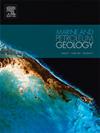Diagenetic controls on sweet spots pore types and reservoir quality of Permian tight sandstones in the Ordos Basin, China
IF 3.7
2区 地球科学
Q1 GEOSCIENCES, MULTIDISCIPLINARY
引用次数: 0
Abstract
Identification of sweet spots in tight sandstone reservoirs is crucial to the effective economic development of tight oil and gas. The pore types and porosity-permeability relationships in the sweet spots of tight sandstones are primarily controlled by sedimentary and diagenetic processes. All of the Permian tight sandstone sequences in the northeastern Ordos Basin were deposited under similar depositional environment with sediments supplied from the same source. Understanding the variations of the petrophysical properties of the Permian tight sandstones would thus provide insight into the control of reservoir quality by the diagenetic process. Petrographic and petrophysical analyses were conducted on the Permian tight sandstone sweet spot reservoir interval, revealing the distribution and characteristics of pore types that control reservoir quality. Pore types change from a mix pore type of primary intergranular, secondary dissolution porosity and undifferentiated microporosity in the shallower upper Permian reservoir interval to a secondary dissolution porosity- and microporosity-dominated one in the deeper lower Permian reservoir interval. Porosities decrease from 15.18% in the upper Permian to 10.43% in the lower Permian, while permeabilities decrease from 15.29 mD to 0.85 mD. The primary intergranular porosity decreases from 7.94% to 0%, while the secondary dissolution porosity increases from 4.75% to 6.22%. In contrast, microporosity increases from 3.60% to 4.52%. With increasing burial depth, the intergranular porosity decreases significantly due to mechanical compaction or occlusion by quartz cementation. The precipitation of authigenic clay minerals and ferrous carbonate cementation also contributes to the reduction of primary intergranular porosity. Although the dissolution of feldspars produced more secondary dissolution porosity with increasing burial depth, quartz cementation and authigenic clay minerals resulting from feldspar dissolution limit the porosity increase from mineral dissolution. Changes in pore type proportions and the reduction in total porosity with increasing burial depth alter porosity–permeability relationships. In the shallower upper and middle Permian reservoir intervals, primary intergranular porosity are well developed, typically exhibiting large pore throat sizes. The average medium pore throat radius in the upper and middle Permian reservoirs reaches 0.88 μm and 0.42 μm, respectively, resulting in high permeability. In contrast, the deeper lower Permian reservoir intervals lack primary intergranular porosity and primarily develop secondary dissolution porosity and microporosity, which connect to small pore throats. As a result, the lower Permian reservoir has an average medium pore throat radius of only 0.32 μm, resulting in low permeability. Because the lower Permian reservoirs are dominated by secondary dissolution porosity and microporosity, their porosity–permeability relationships have gentler slope compared to those of the upper and middle Permian reservoirs, where primary intergranular pores are more prevalent.
求助全文
约1分钟内获得全文
求助全文
来源期刊

Marine and Petroleum Geology
地学-地球科学综合
CiteScore
8.80
自引率
14.30%
发文量
475
审稿时长
63 days
期刊介绍:
Marine and Petroleum Geology is the pre-eminent international forum for the exchange of multidisciplinary concepts, interpretations and techniques for all concerned with marine and petroleum geology in industry, government and academia. Rapid bimonthly publication allows early communications of papers or short communications to the geoscience community.
Marine and Petroleum Geology is essential reading for geologists, geophysicists and explorationists in industry, government and academia working in the following areas: marine geology; basin analysis and evaluation; organic geochemistry; reserve/resource estimation; seismic stratigraphy; thermal models of basic evolution; sedimentary geology; continental margins; geophysical interpretation; structural geology/tectonics; formation evaluation techniques; well logging.
 求助内容:
求助内容: 应助结果提醒方式:
应助结果提醒方式:


